This year I decided to make 4 new hot sauce recipes that have been rolling around in my head, from left to right, "Roasted Pineapple Ghost Chili", "Peach-Apricot Datil", "Roasted Pineapple Anaheim" and "Tabasco".





The Datil pepper plants exploded so I finished them up first,





Then Back into the fridge where it will rest a few weeks before sampling, tweaking and bottling...or tossing!
That's one down, got three to go so my wife can have her counter back, next up, the "Roasted Pineapple Ghost Chili", and "Roasted Pineapple Anaheim".








"Roasted Pineapple Ghost Chili", "Peach-Apricot Datil" and "Roasted Pineapple Anaheim" are bottled, the "Tabasco" will sit on charred oak for a few years.
Sauce is removed from the refrigerator and sampled, then placed in a pot and sampled again is it comes up to temp, any tweaks will be done at this time like adding salt or vinegar.








Tabasco Peppers will rest on toasted Charred white oak for a year or two, maybe longer in a dark closet.
These do not need to be kept under refrigeration.

- After I collected enough peppers to start the sauces, they are chopped in a food processor with a touch of red wine vinegar a few bits of fresh onion and fresh garlic.



- A little white vinegar is poured over top of the peppers, then salt is added to form a salt crust. Vinegar is then placed in the airlocks and the airlocks and lids are screwed onto the mason jars.

The Datil pepper plants exploded so I finished them up first,
- For the "Peach-Apricot Datil Hot Pepper Sauce", The fermented peppers are then run through a food processor with a few peaches from the local farm and a bit of white vinegar is added to thin out a bit. Then the sauce is placed in a pot with some Apricot preserves then simmered for half an hour. Then the mixture is strained and the liquid will rest in the refrigerator and the pulp will be dehydrated.

- At this point, If I want to add a smoky flavor to this sauce I will remove these bits then cold smoke them for about an hour on a mild smoke. Sometimes I may not even use the pulp for the sauce but may use it for making Rubs and Seasoned Salts.

- The dried pulp is ground to a powder and placed back in a pot with the drained sauce and simmered again. This will help with the mouth feel and viscosity of the sauce, less pulp makes it thinner as opposed to more makes it thicker. This gives you control off the viscosity. I prefer thicker so it clings to the food.



Then Back into the fridge where it will rest a few weeks before sampling, tweaking and bottling...or tossing!
That's one down, got three to go so my wife can have her counter back, next up, the "Roasted Pineapple Ghost Chili", and "Roasted Pineapple Anaheim".
- A very ripe pineapple is trimmed.

- Pineapples are then roasted on a sear station, cored, chopped and placed in the ferment bottles. Here they will sit for a few weeks. Whats nice about this is, there's no rush, you can get to it when you get to it.


- Pineapples are cubed and placed in the jar, topped with more vinegar and some salt. Just look for mold on top, once that starts scoop it off and cook the sauce.
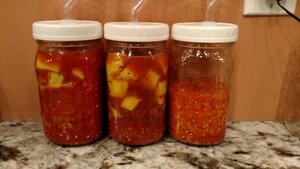
- Sauce is cooked, run through a food processor and strained, the pulp will be dehydrated, then run through a coffee grinder then some pulp will be added back to the sauce for body, just as the "Peach Apricot Datil Hot Sauce".
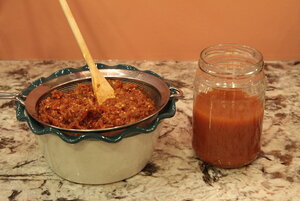


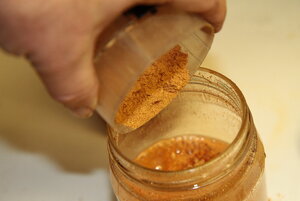
"Roasted Pineapple Ghost Chili", "Peach-Apricot Datil" and "Roasted Pineapple Anaheim" are bottled, the "Tabasco" will sit on charred oak for a few years.
Sauce is removed from the refrigerator and sampled, then placed in a pot and sampled again is it comes up to temp, any tweaks will be done at this time like adding salt or vinegar.
- Bottles, caps and dashers are sterilized in a pot of boiling water, each sauce is heated on the stove top and brought to a simmer and simmered for 10 minutes then poured into the hot woozies. The bottles are then capped and placed in the box upside down for half an hour or so.

- Bottles are removed from the box and thoroughly cleaned.

- Once the filled bottles have cooled enough to handle, they are labeled.

- Then a safety seal is applied.
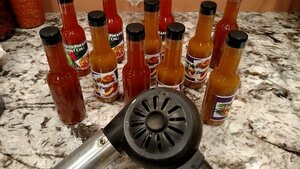
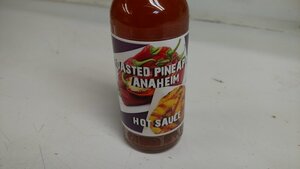
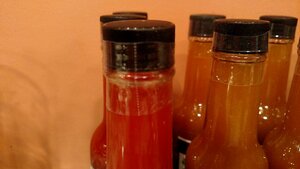
- What about the Tabasco? A stave of charred Oak is removed from my whiskey and a cube is cut from the end. The cube is then charred and dowsed in water.

- The charred oak is placed in the center of the fermenting peppers.
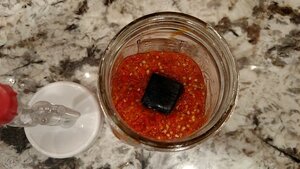
Tabasco Peppers will rest on toasted Charred white oak for a year or two, maybe longer in a dark closet.
These do not need to be kept under refrigeration.
- If you place the sauce in a jar under refrigeration, the pulp will eventually drop out of suspension and you can have a thin sauce and a thicker sauce, just by carefully pouring the thinner liquid off the top.
- I always prefer it somewhat thick so it clings to the food.
- You can also make use of extra pulp, boil the pulp with some apple juice or water, add a a lot of salt, about 50/50, dehydrate again, smoke the "leather like" pulp then crumble through a colander for some awesome coarse seasoned salt.
Last edited:








